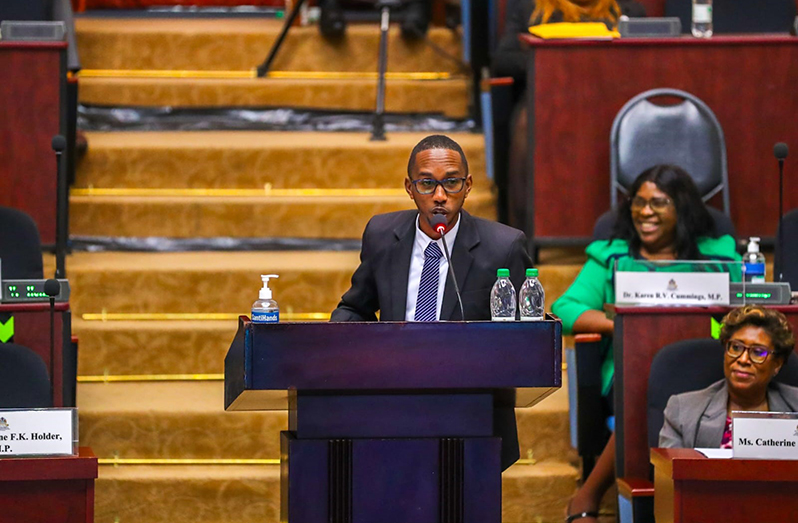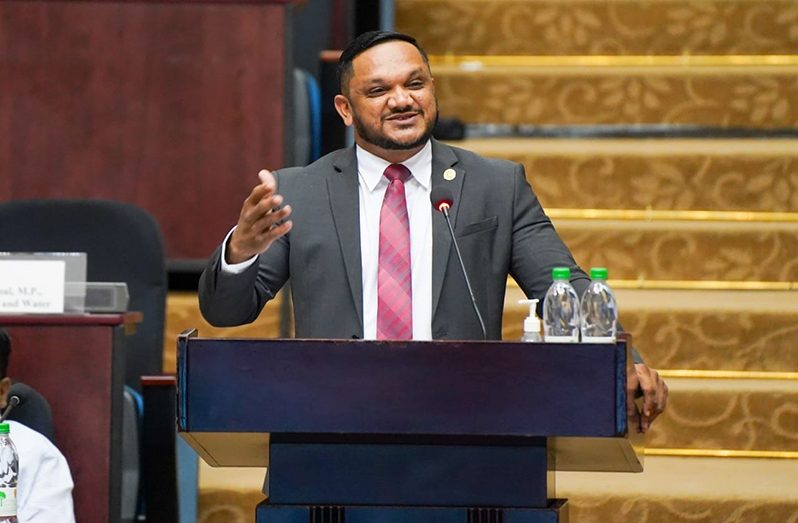–Minister Bharrat sets the record straight on PPP/C gov’t revival of critical sectors
–highlights bankruptcy of forestry, other areas under coalition gov’t
MINISTER of Natural Resources, Vickram Bharrat, slammed the A Partnership for National Unity + Alliance For Change (APNU+AFC) Opposition, on Tuesday, for attempting to turn a blind eye to the numerous incentives being offered by the current government for the ordinary Guyanese and the upward trajectory of the nation.
“Are we so divorced from reality?” the minister said to the House, during the second day of budget debates.
While rebutting the narratives peddled by the Opposition Member of Parliament (MP), Shurwayne Holder, the minister outlined how the natural resources sector has reached new heights under the People’s Progressive Party/Civic (PPP/C) Government.
Although Holder attempted to paint a picture of the period 2015-2020 being a bed of roses under the previous coalition government, Minister Bharrat proved otherwise.
Placing attention on forestry, he spared no effort to highlight the deplorable state that the forestry sub-sector was left in.
“…In 2020, when we took over, the Guyana Forestry Commission was bankrupt. A country that [holds] the second highest forest coverage in the world, after Suriname, with over 1,000 different species was bankrupt,” he said.
The Commission, which is responsible for the administration and management of all state-owned forest lands, had descended into a state of bankruptcy over the five-year period under the coalition, despite having a surplus of more than $4 billion at the end of 2015.
However, the Guyana Forestry Commission (GFC) got a new lease on life when the PPP/C assumed office in 2020, and despite heckling from the Opposition benches, Minister Bharrat was not deterred from laying out the facts.
While admitting that exportation within the sector has declined, Bharrat underscored that with Guyana’s rapid development and the increase in demand among locals for logs, it would be unwise to export all of the nation’s primary products.
“Export has declined but is it that [this] is the main objective of the Forestry sector?” he asked, while answering: “One of the reasons why we still remain a developing country today even though we have so many natural resources is because we have always exported our primary products.”
Refusing to leave Guyanese on the backburners, Minister Bharrat said: “The local demand is growing so much that the Guyana Forestry Commission is supplying local demand. Should we neglect the local demand and export because we want to come here report that our export figures are glorious?”
While comparing the stark difference with the increase in investor confidence under the two administrations, the minister said: “Increased demand didn’t happen just like that… it is because of the prudent management of the economy and our ability to bring in investors in almost every single sector across the country; that is why the demand [has] increased. It is because of the confidence that people [have] in the economy and the government…”
Staying on the topic of forestry, the minister urged the House to set politics aside and laud the GFC, especially since the nation has over 87 per cent forest coverage and a low deforestation rate.
“In our Low Carbon Development Strategy 2030, our commitment is 0.07 per cent deforestation. Today our deforestation rate is 0.036 per cent and we are working to bring down that deforestation even further by adding value to products and not exporting our logs,” he boasted.
Despite the misinformation surrounding Guyana’s carbon credit deal, Minister Bharrat decided to set the record straight.
“We never sold any forests, we sold carbon credits,” he firmly remarked.
In December 2022, the Architecture for REDD+ Transactions (ART) issued the world’s first TREES credits to Guyana.
This marked a milestone, as it was the first time a country was issued carbon credits specifically designed for the voluntary and compliance carbon markets for successfully preventing forest loss and degradation — a process known as jurisdictional REDD+.
Following the completion of an independent validation and verification process and approval by the ART Board of Directors, ART issued 33.47 million TREES credits to Guyana for the five-year period from 2016 to 2020.
This paved the way for a historic agreement between Hess Corporation and the Government of Guyana, whereby the oil giants opted to purchase about one-third of all Guyana’s credits (issued and anticipated) up to 2030.
The agreement will generate a minimum of US$750 million for Guyana over the coming decade and represents a major milestone on the journey towards a vision first set out in 2007.
With the aim of improving the sub-sector, Minister Bharrat also said that this is the reason why $400 million was allocated in Budget 2024 to commence the mineral inventory process in the mining districts.
Bharrat sternly said that the PPP/C Government is focused on strengthening transparency and accountability, and it is through proper management of the nation’s oil and gas revenues.
Unlike the Opposition, according to him, the Irfaan-Ali led administration has set in place legislation and measures to ensure that there is prudent management.
NO HIDDEN TRANSACTIONS
Using the Natural Resource Fund (NRF) Act (2021) as an example of how there are no hidden transactions within the oil and gas sector, he remarked: “…We have safeguards to ensure that [there] is transparency and accountability, pure transparency and accountability in the sector.”
The amended Act, which came into operation on January 1, 2022, represents a significant improvement in transparency and accountability and overall management of Guyana’s natural resource wealth.

In accordance with the Act: “All withdrawals from the NRF to finance the national budget are subject to approval by the National Assembly. Once the budget is approved, only then the withdrawal can be effected, and this is done, not all at once, but throughout the fiscal year in various sums.”
And, all withdrawals from the NRF have to be deposited into the Consolidated Fund. The withdrawal rule of the fund is not calibrated to withdraw all of the monies from the NRF.
As the heated debate continued, Minister Bharrat blasted Holder for his attempt to “score cheap political points” by stating that this year’s fiscal package has no benefits for the ordinary Guyanese.
“Budget 2024 is a colossal failure and does not address the immediate needs of our people,” Holder said.
Minister Bharrat, however, responded by listing not only the incentives but disclosing how many thousands of Guyanese will benefit significantly.
During his presentation, Holder called for the income tax threshold to be raised. However, for Budget 2024, the threshold has increased to $100,000 monthly. The income tax threshold was increased from $65,000 to $75,000 in 2022 and subsequently to $85,000 last year.
This adjustment will see some 13,000 persons being removed from paying income taxes, and further result in some $4.8 billion being transferred to workers across the country as an increase in disposable income.
It was reported in 2022 that returns from VAT and excise taxes declined by 10.2 per cent following tax reforms being instituted to cushion the rising cost of living, after the coalition government had imposed over 200 taxes on Guyanese from 2015-2020.
WIDER AGENDA
The tax reforms form part of the government’s wider agenda to improve the quality of life in Guyana and address immediate economic challenges that affect Guyanese.
According to Minister Bharrat: “Budget 2024 is a continuation of our programme, our policies and our projects to build out a new modern Guyana that all of us want to see, and to pass on to future generations to come Mr. Speaker, Budget 2024 is building on the foundation that was started in 2020, 2021, 2022 and 2023.”



.jpg)








